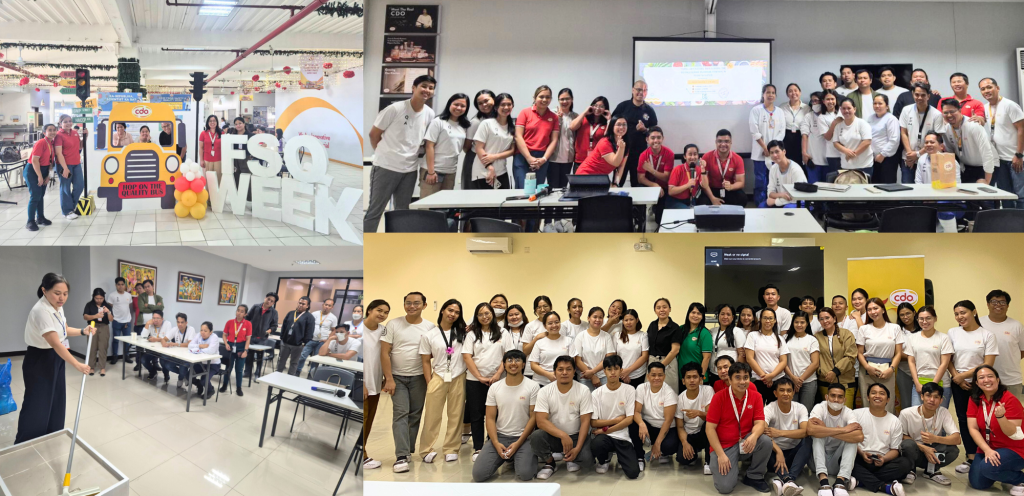In food manufacturing environments, the persistent presence of water or moisture on floors remains a commonly underestimated hazard. Although water plays a vital role in sanitation processes, when not properly managed, it can become a significant source of microbiological contamination. Damp floors provide ideal conditions for the survival and spread of harmful pathogens such as Listeria monocytogenes and Salmonella, increasing the risk of cross-contamination within production areas.
This topic was at the core of a technical seminar conducted by Bon Gre Corporation for Foodsphere Inc., held during Foodsphere’s Food Safety and Quality Week 2025 last June 2 – 5. This weeklong initiative is part of Foodsphere’s ongoing commitment to embed food safety deeply within its operational culture. The event serves as a platform to educate employees, share industry knowledge, and reinforce company-wide accountability for upholding the highest food safety and quality standards.
To support the seminar’s key message, scientific literature was presented to illustrate how moisture on floors and drains directly contributes to microbiological hazards. A 2023 study by Koutsoumanis et al. revealed the presence of Listeria monocytogenes across various surfaces in food production facilities, with drainage systems and floors identified as high-risk zones. Similarly, a study by Morita et al. (2005) confirmed the presence of Salmonella on both on-line and off-line processing floors; thus, highlighting the widespread risk posed by moisture-retaining surfaces.
Further evidence presented in the seminar came from the work of Berrang and Frank (2012), who demonstrated how microbial spread can occur through aerosols. In their experiment, Listeria innocua—a non-pathogenic surrogate—was introduced into PVC drain samples. When these drains were sprayed with water at 6.89 kPa for just two seconds from a one-meter distance, the bacteria became aerosolized and were detected on sedimentation plates placed up to four meters away. This key finding underscores that even routine cleaning activities can unintentionally spread contaminants if floors and drains are not properly managed.
These insights reinforce the importance of maintaining dry floors as a key preventive control. Moist conditions significantly support microbial harborage and multiplication. To address this, facilities must adopt a proactive cleaning and moisture control program that includes proper floor design, drainage, and drying practices.
As part of its commitment to supporting hygienic environments, Bon Gre Corporation supplies the Haug Bürsten floor squeegee—a high-quality, industry-approved tool manufactured in Germany. Engineered specifically for the food industry, this squeegee efficiently removes standing water, aids compliance with food safety protocols and supports the maintenance of dry, sanitary floors.
For more information on moisture control solutions and hygiene tools, contact Bon Gre Corporation at [email protected] or call +639171054121.

References:
Berrang, M. and Frank, J. (2012). Generation of Airborne Listeria Innocua from Model Floor Drainst. Journal of Food Protection, 75(7), pp.1328–1331. doi:https://doi.org/10.4315/0362-028X.JFP-12-021.
Koutsoumanis, K., Allende, A., Bolton, D., Bover-Cid, S., Chemaly, M., De Cesare, A., Herman, L., Hilbert, F., Lindqvist, R., Nauta, M., Nonno, R., Peixe, L., Ru, G., Simmons, M., Skandamis, P., Suffredini, E., Fox, E., Gosling, R. (Becky), Gil, B.M. and Møretrø, T. (2023). Persistence of Microbiological Hazards in Food and Feed Production and Processing Environments. efsa Journal. doi:https://doi.org/10.2903/j.efsa.2024.8521.
Morita, T., Kitazawa , H., Iida, T. and Kamata, S. (2005). Prevention of Salmonella cross-contamination in an Oilmeal Manufacturing Plant. Journal of Applied Microbiology, pp.1364–5072. doi:https://doi.org/10.1111/j.1365-2672.2006.02972.x.
Anne Camille C. Vargas is a sales and marketing executive with over 15 years of industry experience and is currently pursuing her MSc in Food Safety at the University of Edinburgh. She advocates for science-based food safety practices and leads strategic initiatives at Bon Gre Corporation to promote hygienic standards in food production environments.
